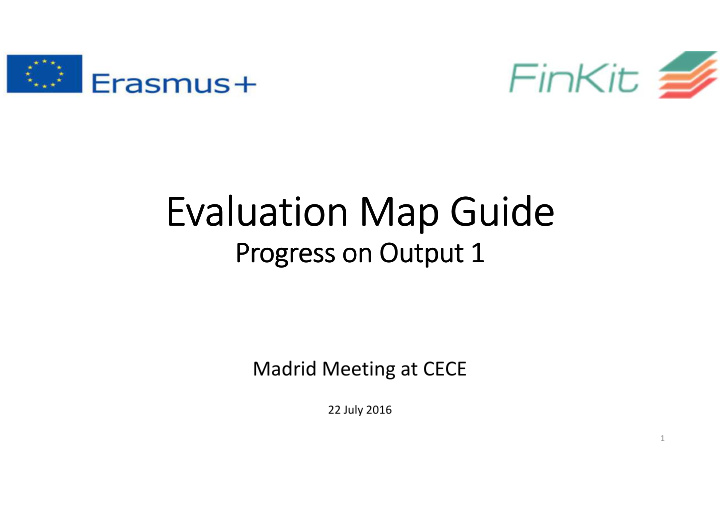



Evaluation Map Guide Evaluation Map Guide Evaluation Map Guide Evaluation Map Guide Progress on Output 1 Progress on Output 1 Progress on Output 1 Progress on Output 1 Madrid Meeting at CECE 22 July 2016 1
Contents 1. Basic assumptions of the EMG 2. Key concepts 3. Phases of the Evaluation Map Guide 4. Analysis dimensons of the projects 5. Identification of the relevant projects 6. Main characteristics of the projects 7. Main challenges for the FinKIT team 2
1. Basic assumptions of the EMG Evaluation Map Guide is a set of materials that allow trainers to take their evaluative decisions regarding projects, materials and methodologies to work with specific social groups in terms of training on financial literacy. 3
2. Key concepts • relevance of the project/initiatives; • effectiveness of outputs; • impact of the project/initiatives; • quality of project/initiatives partnership; • medium term sustainability potential. 4
3. Phases of the Evaluation Map Guide • Analysis of projects already developed • Deadline: 31 May (30 September) 2016 • Contributions to the development of evaluation tools • Deadline: 30 September (31 October) 2016 • Validation of the evaluation map • Deadline: 31 December 2016 5
4. Analysis dimensons of the projects • Types of promoters; • Types of projects; • Aims of the projects; • Target population; • Products/actions developed; • Results achieved. 6
5. Identification of the relevant projects by countries/partners 7
5.1. Italy – Projects identified • ABACO project • Multipartner (European Project) • Welfare finanziario comunitario • Municipality (Milano) • Rendimento e rischio • Brokeer • Educazione finanziaria - Banca della Maremma • Bank (Banca della Maremma) • FEDUF project • Fondazione per l’Educazione Finanziaria e al Risparmio (ABI) 8
5.2. Spain – Projects identified • Finances for all (Finanzas para Todos) • Spanish Central Bank • Go ahead with your future: Finances for Life • Bank (BBVA) • Future retirement (Jubilación de futuro) • Bank (BBVA) 9
5.3. Portugal – Projects identified • “Todos contam” - National Plan for Financial Education • National Council of Financial Supervisors • Financial Education Project • APB - Portuguese Banking Association • CETELEM – Financial Literacy Sessions • Bank (BNP Paribas) • Manage and Save (Gerir e Poupar) • DECO (Portuguese Consumer Association) 10
6. Main characteristics of the projects • Diversity of promoters (related to the banking system); • Generic target population and micro entrepreneurs; • Development of pedagogical tools (guides, basic books and reports); • Training (dissemination sessions); • Low long term sustainability related to funding. 11
7. Main challenges for the FinKIT team To understand the tensions between: • Applied studies or “intervention projects”; • Actions located in time or ongoing projects; • Projects oriented to all population or projects oriented to target groups; • Create written pedagogical suports or online applications; • Achieve the aims of the project or ensure the long term sustainability. 12
Final consideration for discussion What kind of benchmarking can we develop for the EMG of FinKIT Project? 13
Recommend
More recommend